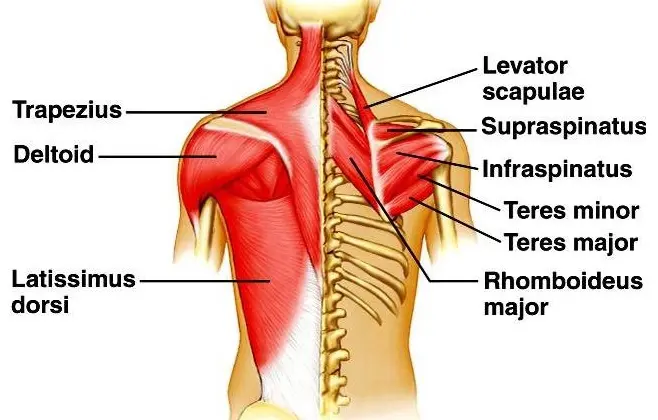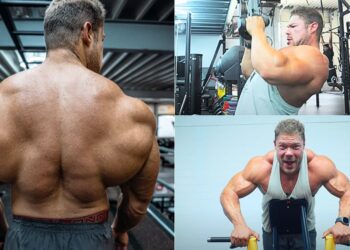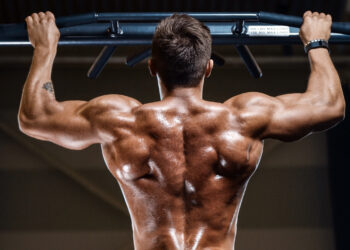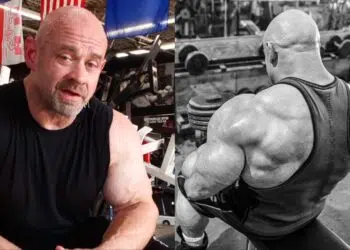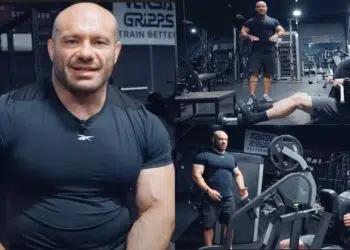Your body is amazing! It’s made up of 206 bones, over 600 muscles, billions of cells, dozens of organs, and a whole lot of different fluids too. Despite this complexity, your body is also pretty dumb. It can’t really tell the difference between a state-of-the-art lat-pulldown machine and doing pull-ups from a tree branch. All it knows is work, and providing that work is sufficiently intense, your body will adapt by getting fitter and stronger.
Because of this lack of awareness, you don’t necessarily need lots of sophisticated or expensive training equipment to build the body of your dreams. While you can use things like barbells, dumbbells, and machines to sculpt your body, you can also get a great workout using nothing more than your own bodyweight.
Using a suspension trainer, such as a TRX, can help too. A TRX allows you to make the most of leverage and your bodyweight to attack your muscles from a variety of angles. In this article, we are going to reveal the best TRX exercises for building a rock-solid back!
What is a TRX?
TRX, which is short for Total Resistance (E)Xercise, is an exercise device consisting of two straps, D-shaped handles, and an anchor. It’s the brainchild of ex-Navy SEAL Randy Hetrick, who created his first TRX after realizing that staying combat fit while on deployment was never easy as workout facilities were always in short supply. Hetrick started TRX in 2005 to create a “gym in a bag” that SEAL operatives could take with them wherever they were deployed.
TRX trainers quickly became popular in and out of the military. They are now used by commercial gyms, law enforcement, pro sports teams, academic institutions, CrossFit, and are very popular with home exercisers too.
Light, compact, versatile, and portable, TRXs can be used to train virtually every muscle in your body. While you are limited to working out with just your body weight for resistance, you can adjust the angle of your body to make your chosen exercises harder or easier as required.
Level Up Your Fitness: Join our 💪 strong community in Fitness Volt Newsletter. Get daily inspiration, expert-backed workouts, nutrition tips, the latest in strength sports, and the support you need to reach your goals. Subscribe for free!
TRXs are especially good for training your upper back. They provide an excellent alternative to more traditional back-building exercises such as pull-ups, pulldowns, bent-over rows, and seated rows.
Back Anatomy
Before you start building the rock-solid back of your dreams, it’s worth learning a little more about the muscles that make up this large and important group of muscles. Because your back is made up of several different individual parts, and each one has a different function, knowing some basic anatomy and physiology will help you identify the best back building exercises and create workouts that are both balanced and effective.
The main muscles that make up your back are (1):
Latissimus dorsi: Located on the side of your back, your latissimus dorsi, or lats for short, stretches from your armpits down to your lower back and ribs. When well-developed, these muscles look like wings. The functions of the lats are:
- Shoulder adduction
- Shoulder extension
- Shoulder medial rotation
Back Anatomy Muscles
Trapezius: Known as the traps for short, there are three sections to your traps, and each one has a different function. The traps are a large, diamond-shaped muscle that covers your upper back. It controls your shoulder girdle, which is made up of your scapulae or shoulder blades, and your clavicles or collar bones. The functions of the traps are:
- Elevation of the shoulder girdle – upper traps
- Retraction of the shoulder girdle – middle traps
- Depression of the shoulder girdle – lower traps
Rhomboids: These smaller muscles are located beneath your mid-traps and between your shoulder blades. They work alongside your mid-traps and are responsible for shoulder girdle retraction.
Erector spinae: These are the muscles that make up your lower back. Their main job is the extension of your spine. The erector spinae runs up either side of your spinal column. They are also involved in keeping your spine rigid and stable during exercises like deadlifts, squats, and bent over rows. Weak erector spinae are a common cause of lower back pain. Strengthening the erector spinae can help reduce the likelihood and severity of lower back pain (1).
The Best TRX exercises for a rock-solid back
Now you have a grasp of basic back muscle anatomy and function, it’s time to get busy building a rock-solid back you can be proud of. Here is a list of the best TRX back exercises. Use them in place of or alongside your regular back training exercises.
1- TRX inverted rows
If you only do one TRX exercise for your back, this is the one to choose. It works your latissimus dorsi, mid traps, and rhomboids, and involves your erector spinae too. This move is an excellent alternative for things like bent-over rows and seated rows.
How to do it:
- Adjust your TRX to around waist-height. Sit on the floor below the straps. Grab the handles and, with your arms straight, place your feet flat on the floor and lift your hips up so your knees, hips, and shoulders form a straight line.
- Keeping your body straight and your core tight, bend your arms and pull your body up to the handles. Keep your elbows close to your sides and your wrists straight.
- Extend your arms and repeat.
- Make this exercise easier by bending your legs, or harder by placing your feet on an exercise bench or wearing a weighted vest.
2- TRX single-arm rows
A lot of people are surprised to learn that they can do single-arm exercises with a TRX. All you need to do is thread one handle through the other to create a secure grip for one hand. This single-limb exercise is an excellent alternative to single-arm dumbbell rows. It will help identify and fix left-to-right strength and muscle size imbalances.
How to do it:
- Adjust the straps, so the handles are at waist-height. Grip the handles in one hand and lean back, feet flat at on the floor, and legs straight.
- Bend your arm and, without twisting your shoulders or your hips, pull yourself up to the handle. Extend your arm and repeat. Once you have completed all your reps, switch arms and do the same number of reps on the other.
- Make this exercise harder by extending the straps and leaning further back. Make it easier by shortening the straps and putting your body at a shallower angle.
3- TRX face pulls
Face pulls are typically performed using an adjustable pulley machine along with a rope handle. They work all the muscles across and between your shoulder blades, namely your rhomboids and mid-traps. This exercise also involves your posterior deltoids. Face pulls are not just a good exercise for upper back size and strength. They are also good for your posture.
How to do it:
Level Up Your Fitness: Join our 💪 strong community in Fitness Volt Newsletter. Get daily inspiration, expert-backed workouts, nutrition tips, the latest in strength sports, and the support you need to reach your goals. Subscribe for free!
- Hold a TRX handle in each hand and lean back, so your arms are straight. Turn your palms down to face the floor.
- Keeping your body straight, bend your arms and pull your head up between the handles. Keep your neck neutral – do not thrust your head forward.
- Extend your arms and repeat.
- Make this exercise harder by moving your feet further away and leaning back more. Make it easier by keeping your body more upright.
4- TRX power pulls
This explosive exercise works all of your back muscles and also provides your core and biceps with a good workout. It requires a lot of coordination, and it’s also pretty intense. Make sure you have mastered the TRX single-arm row before attempting this much more advanced exercise.
How to do it:
- Set yourself up as if you are going to do TRX single-arm rows (exercise #2). Extend your non-working arm down behind you toward the floor.
- Starting with your arm straight, explosively bend your elbow and reach up the strap with your opposite arm. Rotate your shoulders to try and reach a little higher.
- Unwind your waist, extend your arm, and reach back down to the floor.
- Make this exercise harder by lengthening the strap, or easier by shortening it.
5- TRX pull-ups
Pull-ups are a classic back building exercise. Working your lats and lower traps, as well as your biceps, this move is one back building exercise you cannot afford to skip. TRX pull-ups are a little easier than regular pull-ups because your feet remain on the floor.
How to do it:
- Shorten the straps on your TRX so that, when you sit beneath the handles, you can just about reach them.
- Holding the handles and with your legs out straight in front of you, bend your arms and pull yourself up. Allow your wrists to rotate naturally.
- Extend your arms and repeat.
- Supercharge this exercise by keeping your legs locked in place and lifting them off the floor. This is called an L-pull-up.
6- TRX reverse flyes
A lot of exercisers think that reverse flyes, usually done with dumbbells, cables, or on a reverse flye machine, only work the posterior deltoids. Not true! This challenging exercise can also be done using a TRX, and it works the middle trapezius and the rhomboids, too, making it an excellent postural exercise.
How to do it:
- Take a TRX handle in each hand and adopt a staggered stance for balance. Lean back and extend your arms.
- Keeping your arms straight, pull the handles apart and lift your chest up toward the ceiling. Keep your neck neutral and do not thrust your head forward. Squeeze your shoulders down and back.
- Return to the starting position and repeat.
- Use your legs more to make this exercise more manageable, or less to make it harder.
7- TRX Y-raises
TRX Y-raises are so-called because that’s the shape your arms make at the mid-point of each rep. This exercise works your mid and lower traps, as well as your rhomboids and posterior deltoids. Your erector spinae also gets in on the act as it has to work to keep your body straight. TRX Y-raises are an excellent postural exercise.
How to do it:
- Grab a TRX handle in each hand and lean back. Start with just a slight lean because this is a challenging exercise. Your arms should be straight and extended in front of you at about shoulder-height.
- Keeping your elbows and wrists straight, open your arms and raise them up into a Y-shape above your head.
- Return to the starting position and repeat.
- Adopt a staggered stance and use your rear leg for assistance to make this exercise easier.
8- TRX face pull with external rotation
This exercise combines exercise #3 with an extra movement to create a challenging but very effective upper back exercise. Targeting your mid-traps, rhomboids, posterior deltoids, erector spinae, and biceps, this exercise can help improve your posture and shoulder health as it builds your upper back.
How to do it:
- With a TRX handle in each hand, lean back, so your arms are straight. Bend your arms and pull yourself up to the handles. Focus on leading with your elbows and keeping your wrists straight.
- From this position, externally rotate your upper arms, so your palms are facing forward.
- Slowly unwind your arms and repeat.
- Adopt a staggered stance and use your rear leg for assistance to make this exercise easier.
9- TRX good mornings
Good mornings are an old-school barbell back and hamstring exercise. They are a little controversial because some trainers believe that they can cause back injuries. While this is true if they are performed incorrectly, good mornings are still a very useful back builder, and this TRX version is a whole lot safer anyway.
How to do it:
- Hold your TRX handles above your head. The strap should be parallel to the floor. Brace your abs and look straight ahead. This is your starting position.
- Push your hips back and lower your arms so that your body resembles a side on V-shape (<).
- Drive your hips forward and lift your arms back overhead. That’s one rep – keep going!
10- TRX back bridge
This isometric or static back exercise works your erector spinae, as well as your glutes and hamstrings. Because no movement is involved, this exercise is easy on your spine. It may be suitable for people suffering back pain. Of course, you should always speak to your doctor before exercising if you have any old or current injuries.
How to do it:
- Sit on the floor and place your feet in the handles. Your heels should fit neatly and snugly into the webbing straps. Lie on the floor with your legs straight.
- Push down through your heels and lift your body off the floor. Extend your arms up to the ceiling. Keep your body straight and rigid for the duration of your set.
- Lower your but back to the floor and rest.
FAQs
Do you have any questions? We’ve got the answers! If you can’t find the answer you want below, drop us a line in the comments section, and we’ll get back to you as soon as we can.
Can I use a TRX to build muscle?
Yes! Your body cannot really differentiate between barbell, dumbbell, and TRX exercises. So long as you train hard, you can definitely build bigger muscles with a TRX (3). Not convinced? Check out the upper body development of most male gymnasts. They do a lot of ring work, and that is just an advanced version of suspension training.
I don't have a TRX - how can I do these exercises?
In some cases, you can use a different piece of exercise equipment. TRX exercises can often be done using a cable machine, such as face pulls. Others, like back bridges, can be done using an exercise bench. You can also make your own TRX using truck tie-down straps or even lengths of rope. Just add some D-shaped handles, and you are all set. There are also budget-friendly non-TRX suspension trainers available.
How do I make TRX exercises harder?
Most TRX exercises can be made more challenging by adjusting the length of the straps to increase the load on your hands or feet. You can also move your feet further away from the anchor point, lengthening the lever and decreasing your mechanical advantage. You may need to experiment to discover the best way to progress (or regress) your chosen exercise. Still, most TRX moves can be adjusted to suit your current level of strength.
Some exercisers also wear weighted vests for TRX workouts. Make sure your anchor point is strong enough to support this extra load.
Do TRX exercises work your core?
Most TRX exercises work your core, as well as the muscles you are targeting. That’s because you need to keep your body straight as you move your arms and/or legs. In some exercises, core activation is minimal, but some TRX exercises are real core blasters. Make sure you keep your abs braced during every TRX exercise.
The wrap-up
TRX training is popular with the military for a very good reason – it works! Light and portable, if you have a TRX or similar suspension trainer, you can work virtually every muscle in your body without using barbells, dumbbells, kettlebells, or resistance training machines.
Even if you have access to a well-equipped gym, adding TRX exercises to your workouts can provide extra variety to keep things fresh and fun. Use these best TRX exercises to build a rock-solid back – or any other muscle group for that matter!
References:
- Encyclopedia Britannica: Erector Spinae Anatomy https://www.britannica.com
- PubMed: A Systematic Review of the Effects of Exercise and Physical Activity on Non-Specific Chronic Low Back Pain https://www.ncbi.nlm.nih.gov
- American Council on Exercise: Investigating the Acute and Chronic Health Benefits of TRX® Suspension Training® https://www.acefitness.org

